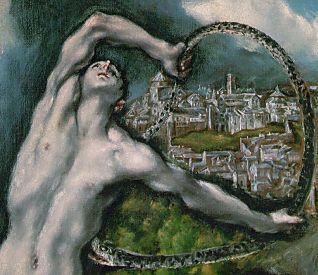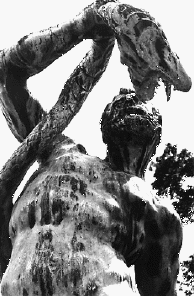AUTEUR-DRIVEN VEHICLES
THE NEW NEW LAOCOON
The starry heavens above me
The moral law within
So the world appears
Through this mist of tears
--Nick Cave (1997)
 The problematic myth of the lone genius is driven by the romantic concept that a singular being may embody the spirit of the times. This myth-on-top-of-a-myth -- the incommensurable zeitgeist (demoted to the episteme by Foucault) informing the work of an intensely-attuned individual -- is also the main spring driving the auteur-driven vehicle.
The problematic myth of the lone genius is driven by the romantic concept that a singular being may embody the spirit of the times. This myth-on-top-of-a-myth -- the incommensurable zeitgeist (demoted to the episteme by Foucault) informing the work of an intensely-attuned individual -- is also the main spring driving the auteur-driven vehicle.What distinguishes the auteur-driven vehicle from everything else is the presence of the guiding spirit of the plenitude of Time Itself -- a presence problematized by the assumption of the mantle of omniscience by one (sometimes two) very clever persons.
In the case of a film director (Tarkovsky, Godard, Bresson, Kurosawa), the auteur formula is part-and-parcel of the idiom of the art film. In the case of theater (Bertolt Brecht, Eugène Ionesco, Peter Brook, Tom Stoppard), the phenomenon is more precisely focused on the ability to assemble the ensemble, as Wenders has tried to do in a more prosaic manner and with less success in film.
In architecture and landscape architecture the auteur-driven vehicle is the so-called "boutique firm". Whether or not this term is pejorative depends on which side of the divide you sit on -- which side of the partition. The nature of this type of firm is to present a "signature" style while proposing an alternative to the service bureau, or the corporate design office. Whether such claims are valid usually rises and falls on the reputation of a "name" and a "style" versus something more vital and "of the times" as in film or theater. This "something more" is intellectual substance. What all the nouvelle vague filmmakers had in common was a desire for the film to also act as a critique of cinema and its times. Style is not sufficient to fuel the auteur-driven vehicle for long, and this is why most run "out of petrol" after a decade or so.
The low end of the auteur-driven phenomenon is the cult of the personality in its most prosaic (paranoid) form, and the cult of genius in its highest. The latter warrants/bears close scrutiny, while the former is just as well left alone (ignored). The ensemble and the signature, the form and its progenitor, the idiom and its maestro, are all relative terms insofar as there is nothing exceptional except the claim to genius.
 Nick Cave's music is an example. What would the dark (brooding), brilliant (poetic), philosophical (dialectic) musings of the misanthropic artist mean without the sonorous ambient force of the violin against the tinkling melodic line of the piano and the ominous "fat" bass line. Wenders picked up Cave in Wings of Desire (1987), as he picked up Lou Reed in Far Away, So Close (1993) for associative magic. Such appropriations are the stuff of the auteur-driven vehicle and automatically undermine the romantic notion of creating something out of nothing. Yet, paradoxically, the zeitgeist is both something and nothing. Moreover, any work that taps into the spirit of the times will carry the amalgam of forces present at that time further, stretching and warping the fabric of time such that new forms emerge infused with the stuff of repressed dreams and nightmares. Such works of art are exceptional because they illuminate the interior of time and draw/cast shadows.
Nick Cave's music is an example. What would the dark (brooding), brilliant (poetic), philosophical (dialectic) musings of the misanthropic artist mean without the sonorous ambient force of the violin against the tinkling melodic line of the piano and the ominous "fat" bass line. Wenders picked up Cave in Wings of Desire (1987), as he picked up Lou Reed in Far Away, So Close (1993) for associative magic. Such appropriations are the stuff of the auteur-driven vehicle and automatically undermine the romantic notion of creating something out of nothing. Yet, paradoxically, the zeitgeist is both something and nothing. Moreover, any work that taps into the spirit of the times will carry the amalgam of forces present at that time further, stretching and warping the fabric of time such that new forms emerge infused with the stuff of repressed dreams and nightmares. Such works of art are exceptional because they illuminate the interior of time and draw/cast shadows.Boutique firms come and go ... Normally, one or two bona fide auteur-driven vehicles emerge every decade. Just now there are dozens upon dozens appearing. Why? Is it that the corporate idiom is so totally (morally/artistically) bankrupt? Is it that architects and landscape architects are tired of working their way through the professional stations of the cross? Is it because there is something wholly radical afoot, and the auteur-driven boutique firm is the best method to press forward? To press the agenda?
All of these unanswerable questions have a single cause -- that is, the professions of architecture and landscape architecture are all-but bankrupt and the would-be artist-designer knows it all too well. The corporate service bureau exists, will always exist, as the Hollywood or Bollywood landslide of lamentable films goes on and on. In the design world the realization seems to be that everything is at stake, although this is also almost always the case. Why is it more so now?
Perhaps it is the fusion thing -- the inexorable movement toward a vital, integral, intelligent form of form-making. The signs of intense pressure, pushing upwards from below, that exist in other fields are beginning to manifest in architectural and landscape-architectural design. That these two traditionally antagonistic fields are merging (against the will of many of the rear guard) is a significant sign that something immense is underway.
Truly, then, the zeitgeist has got us by the -- um -- short hairs. Ante up or fold! Your options will diminish as the floodgates are opened.
Out of sorrow entire worlds have been built
Out of longing great wonders have been willed
They're only little tears, darling, let them spill
And lay your head upon my shoulder
Outside my window the world has gone to war
Are you the one that I've been waiting for?
--Nick Cave (1997)
Gavin Keeney (August 2002)
NOTES
Images (above) - Laocoon #1 (El Greco); Laocoon #2 (Adriaen de Vries)
Of course, Clement Greenberg wrote "Towards a Newer Laocoon" (Partisan Review, 1940), and Lessing wrote Laocoon: An Essay on the Limits of Painting and Poetry (1766), and the Roman copy of the Greek Laocoon dug up during the Renaissance (1506) created a sensation and some may say sparked the Mannerist revolt around about the 1520s (the sack of Rome by Charles V occurred in 1527). Nevertheless, Greenberg's and Lessing's diatribes were primarily arguing for the differentiation of the arts. The New New Laocoon argues for the total merger of everything.
 Historicist Non Sequitur #1 - Some say things began to go awry when Socrates demolished the Homeric universe. Others claim it all started to unravel when medieval scholastics failed to pinpoint how many angels could dance on the head of a pin. Still others believe the great mistake was going off the gold standard. Lacan would, of course, blame American psychoanalysts. Critics of Lacan would blame the 45-minute session. If Nietzsche were alive today, he would no doubt say the world began to fall apart when we started putting milk into little plastic bottles with fake nipples.
Historicist Non Sequitur #1 - Some say things began to go awry when Socrates demolished the Homeric universe. Others claim it all started to unravel when medieval scholastics failed to pinpoint how many angels could dance on the head of a pin. Still others believe the great mistake was going off the gold standard. Lacan would, of course, blame American psychoanalysts. Critics of Lacan would blame the 45-minute session. If Nietzsche were alive today, he would no doubt say the world began to fall apart when we started putting milk into little plastic bottles with fake nipples.Figura serpentina - "Mannerism, which discovered the spontaneity of the mind and recognized art as an autonomous creative activity, developed, in accordance with the spirit of that discovery, the totally new idea of fictitious space." Arnold Hauser, "The Concept of Space in Mannerist Architecture", Mannerism: The Crisis of the Renaissance and the Origin of Modern Art (London: Routledge & Kegan Paul, 1965), p. 279
See also, Leonard Barkin, Unearthing the Past (New Haven: Yale University Press, 1999)
RELATED DOCUMENTS
Architecture's Clay Feet
World Trade Center Burlesque
Vox Populi - Everyone's a Critic
Ipseity, You Say?
Landscape + Architecture
OUTTAKES
"Greenberg felt artistic 'quality' could be judged by the degree of 'purity' art achieved in its own medium and effects exclusive to itself. He was a follower of the philosopher Immanuel Kant and the ideals of in[t]uitive experience and purity. During the '60s his views were questioned by artists and critics who saw them as too self-referential and resistant to change and much contemporary criticism has been dedicated to refuting his theories. Recently, though, his theories have been reconsidered in light of his politics. Although he originally supported Marxism, Social[is]m and Trotsky[is]m he eventually rejected them in favor of an avant-garde that is concerned only with itself." The Greenberg Symposium (ArtNetWeb)
"There is still a great deal of controversy concerning Lessing's relation to rhetoric, the so-called genius-aesthetics of the 1770s, and how his criticism is to be positioned with regard to Romanticism. Incontrovertible is his status as the primary literary theorist and critic of the German Enlightenment." G. E. Lessing (Johns Hopkins University Press)
"Kaurismäki makes pure auteur films in which the vision and the decisions of one player dominate everything. In order to realise his visions, Kaurismäki needs other people. Timo Salminen has been the cameraman for almost all of Kaurismäki's films." - re Aki Kaurismäki (Virtual Finland)
NOTE: This essay first appeared in Counterpunch (08/19/02)
